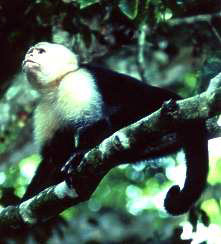Costa Rica is famous for birdwatching—there
are more birds in Costa Rica than in all of North America, but besides
the birds, it is also a great place for “monkey watching.”
In Costa Rica there are four types of monkeys—howler monkeys, spider
monkeys, squirrel monkeys, and capuchin monkeys, and on many of our California
Native trips we see all four.
Of the monkeys in Costa Rica, the squirrel monkey is by far the most
colorful, with his orange-gold hands, feet and back, his olive-green
shoulders and legs, and his black capped head. He is about a foot in
length, not counting his tail, and has an inquisitive little face with
large eyes and small ears. He is very bright and, in proportion to his
body size, has one of the largest brains of all the monkeys. He lives
in the sunlit scrub woodlands, and eats insects, fruit, lizards, eggs,
and small birds. He is also a great dad—the male often carrying
his baby on his back.
The most intelligent monkey in Costa Rica is the capuchin monkey, who
can learn to use sticks as tools to bring food into reach. This is the
monkey we think of as the organ grinder's monkey. The monkey's hair forms
a peak on its head, reminiscent of the cowls of the Capuchin Friars,
after whom it is named. Troops of these monkeys may number thirty or
forty, and they often travel in single file through the trees. They feed
mainly on fruit, supplemented by insects, birds, and eggs.
The largest, and by far the loudest, of Costa Rica's monkeys is the howler
monkey. Howlers are about three feet long, not counting their even longer
tails, and weigh up to twenty pounds. Their main claim to fame is their
ability to produce a deep roar, which can be heard up to three miles
away. The first time I heard a howler was just before dawn when I was
awakened by what sounded like the roaring of lions. The startling sound
is produced and amplified by a bony “sound box” in the howler's
throat. You can hear them just after sundown, before sunrise, and at
the approach of rain. Howlers live in family groups of from five to twenty.
In the early morning and evening they roam slowly through the tree tops,
eating twigs and fruit. During the heat of the afternoon they nap. Howlers
breed throughout the year, and the female may have relations with several
males, who don't seem to mind sharing her.
Click Here for information on our Costa Rica Tours.



